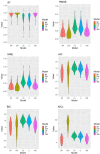Modeling nonlinear inactivation of hygiene indicator bacteria in pig carcasses during scalding at different pHs
- PMID: 39212841
- PMCID: PMC11711692
- DOI: 10.1007/s42770-024-01499-4
Modeling nonlinear inactivation of hygiene indicator bacteria in pig carcasses during scalding at different pHs
Abstract
This study aimed to investigate the influence of adding an alkalizing agent to the scalding water of a slaughterhouse in Brazil to inactivate hygiene indicator bacteria in pig carcasses. Scalding is critical during carcass processing because slaughterhouses' scalding water is constantly renewed; therefore, it is usually contaminated with organic matter, such as faeces and dirt from the previous carcasses. The treatments evaluated consisted of counting Enterobacteriaceae and mesophilic bacteria in pork jowls at 62 °C, 65 °C, 68 C, and 72 °C after 0.0, 1.5, 3.0, 4.5, 6.0, and 7.5 min of simulated scalding at the pHs of 7.0 (control) and 11.0 (after addition of alkalizing agent). Decimal reduction times of hygiene indicator bacteria for all treatments were estimated with different nonlinear bacterial inactivation models. As a result, adding the alkalizing agent did not significantly inactivate most of the bacteria in the studied samples. However, it contributed to the inactivation of some bacteria, mostly belonging to the mesophilic group, at some specific temperatures. The results obtained in the current study can provide useful insights into dealing with pig carcass contamination in a real-world scenario and applying the obtained information in the industrial environment.
Keywords: Enterobacteriaceae; Decimal reduction time; Food industry process; Food safety; Pig slaughter; Predictive microbiology.
© 2024. The Author(s) under exclusive licence to Sociedade Brasileira de Microbiologia.
Conflict of interest statement
Declarations. Conflict of interest: On behalf of all authors, the corresponding author states that there is no conflict of interest.
Figures





References
-
- Martins FM, Trienekens J, Omta O (2022) Impact of buyers’ support on farmer performance and investments in the Brazilian pork supply chain. Int Food Agribus Manag Rev 25(1):1–20. 10.22434/IFAMR2020.0124
-
- Amaral PIS, Campos AT, Esteves Junior RC, Esteves GF, Yanagi Junior T, Leite MECR (2021) Behavioral responses of pigs finished in deep bedding and conventional bed systems. Eng Agric 41(1):25–33. 10.1590/1809-4430-Eng.Agric.v41n1p25-33/2021
-
- Associação Brasileira de Proteína Animal– ABPA (2023) Relatório Anual 2023. Available in: https://abpa-br.org/wp-content/uploads/2023/04/Relatorio-Anual-2023.pdf
-
- Barcellos MD, Saab MSM, Pérez-Cueto FA, Perrin MG, Neves MF, Verbeke W (2011) Pork consumption in Brazil: challenges and opportunities for the Brazilian pork production chain. J Chain Netw Sci 11(2):99–114. 10.3920/JCNS2011.Qpork3
-
- Loretz M, Stephan R, Zweifel C (2011) Antibacterial activity of decontamination treatments for pig carcasses. Food Control 22(8):1121–1125. 10.1016/j.foodcont.2011.01.013
MeSH terms
Grants and funding
LinkOut - more resources
Full Text Sources
Research Materials

